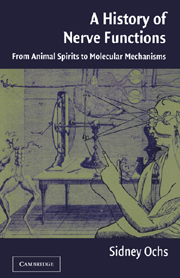Book contents
- Frontmatter
- Contents
- Preface
- 1 Introduction: Greek Science and the Recognition of Nerve as a Channel
- 2 Galen's Physiology of the Nervous System
- 3 Nerve, Brain, and Soul in the Middle Ages
- 4 Renaissance and the New Physiology
- 5 New Physical and Chemical Models of Nerve in the Enlightenment
- 6 New Systematizations of Nerve Function in the Enlightenment
- 7 Electricity as the Agent of Nerve Action
- 8 Nerve Fiber Form and Transformation
- 9 Wallerian Degeneration: Early and Late Phases
- 10 Nerve Regeneration
- 11 Characterization of Axoplasmic Transport
- 12 Molecular Models of Transport
- 13 Actions of Neurotoxins and Neuropathic Changes Related to Transport
- 14 Purposeful Reflexes and Instinctive Behavior
- 15 Neural Events Related to Learning and Memory
- 16 Epilogue: With Observations on the Relation of the Nervous System to Mind
- Bibliography
- Index
Preface
Published online by Cambridge University Press: 13 August 2009
- Frontmatter
- Contents
- Preface
- 1 Introduction: Greek Science and the Recognition of Nerve as a Channel
- 2 Galen's Physiology of the Nervous System
- 3 Nerve, Brain, and Soul in the Middle Ages
- 4 Renaissance and the New Physiology
- 5 New Physical and Chemical Models of Nerve in the Enlightenment
- 6 New Systematizations of Nerve Function in the Enlightenment
- 7 Electricity as the Agent of Nerve Action
- 8 Nerve Fiber Form and Transformation
- 9 Wallerian Degeneration: Early and Late Phases
- 10 Nerve Regeneration
- 11 Characterization of Axoplasmic Transport
- 12 Molecular Models of Transport
- 13 Actions of Neurotoxins and Neuropathic Changes Related to Transport
- 14 Purposeful Reflexes and Instinctive Behavior
- 15 Neural Events Related to Learning and Memory
- 16 Epilogue: With Observations on the Relation of the Nervous System to Mind
- Bibliography
- Index
Summary
Within the last half of the twentieth century, two fundamental properties of nerve were established: in midcentury, the ionic nature of the propagated action potential; and, later in the century, the process in the fibers known as axonal flow, axoplasmic transport, axonal transport, neuroplasmic transport, and so on. By means of the transport mechanism, essential components synthesized in the nerve cell bodies are carried out within the relatively long length of nerve fibers to maintain their viability and function. Components transported include the ion channels and ion pumps needed to maintain membrane potentials all along the length of the fibers, metabolic and structural components supporting the form and viability of the fibers, and substances providing for reception at sensory terminals and neurotransmitters at motor terminals. This is indeed a protean mechanism, fundamental for an understanding of modern neuroscience and a rational basis for interpretation of neuropathies and eventually their therapy.
Although the discovery of the properties and molecular nature of the transport mechanism and related topics is a major theme, this account is not restricted to the last half century. The concept can be traced back to its earliest beginnings in the sixth and fifth centuries b.c., respectively, when philosophy and science had their origins in ancient Greece. Nerves were then conceived of as channels carrying sensory impressions by animal spirits to the brain where consciousness awareness and reasoned judgment were located, and from it willed commands were carried by nerves to actuate the muscles.
Information
- Type
- Chapter
- Information
- A History of Nerve FunctionsFrom Animal Spirits to Molecular Mechanisms, pp. vii - xPublisher: Cambridge University PressPrint publication year: 2004
